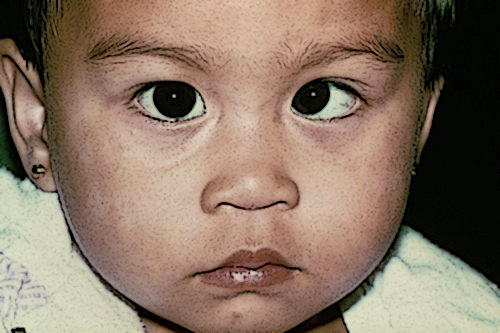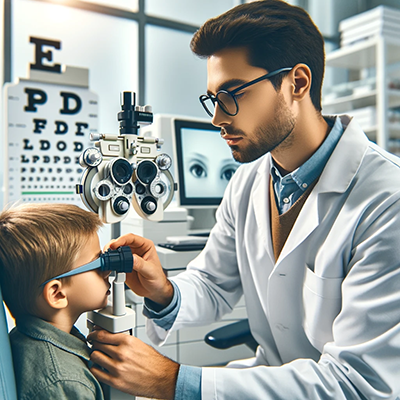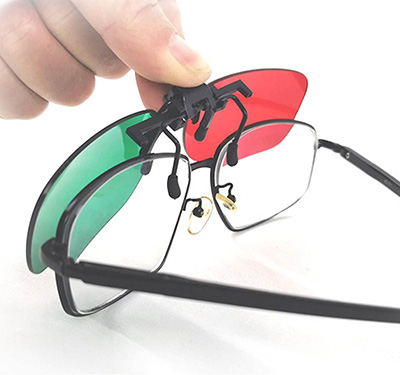Contents
Lazy eye or amblyopia inhibits a child’s vision from reaching its full potential. Amblyopia is one of children’s most prevalent visual issues, impacting about two to three percent of the population. Amblyopia is characterized by decreased or impaired vision in one eye, which cannot be treated by corrective lenses alone.
Amblyopia Causes and Development
This condition results from when the brain prefers one eye over another during early development. This choice may be influenced by several things, such as:

One eye turning inward, outward, upward, or downward known as strabismus, which causes the brain to receive conflicting visual information. Amblyopia develops when the brain suppresses or ignores input from one eye to prevent double vision.
Conditions such as astigmatism, nearsightedness, and farsightedness are refractive defects that result in uneven vision in both eyes. When one eye is better at focusing, the brain may prioritize it over the other, leading to amblyopia in the favored eye.
Form deprivation occurs when the eye is prevented from receiving sharp, focused images by physical impediments or abnormalities such as cataracts, ptosis (drooping eyelids), or corneal opacity. The condition may also result from a lack of visual stimulation during critical stages of visual development.
Symptoms and Diagnosis

Since amblyopia does not manifest with evident visual defects, diagnosing it is frequently challenging. However, parents and caregivers may keep an eye out for some symptoms, like:
Poor sense of depth.
Eye-hand coordination problems.
Bumping into things a lot.
To see better, squint or tilt their head.
A propensity to use one eye more than the other.
Early diagnosis is essential for successful treatment. Babies should have thorough eye exams during infancy and frequent follow-ups during early childhood to detect potential vision issues. Eye care experts use a variety of examinations, such as visual acuity tests, evaluations of ocular alignment, and refraction measurements, to diagnose amblyopia.
Options on How to Get Rid of a Lazy Eye Naturally
Strengthening the weaker eye and promoting its integration with the brain’s visual system are the main objectives of amblyopia treatment. Since the optical system becomes less flexible with age, treatment is most effective when it is started before age 7 or 8. Typical treatment strategies include:
Corrective lenses: Giving prescriptions for glasses or contact lenses to correct refractive faults enhances both eyes’ visual acuity. This can encourage using the weaker eye and stop eyesight from worsening.
Patching: By forcing the brain to rely on the amblyopic eye for a set number of hours each day, patching forces the stronger eye to develop. To get the best outcomes, patching therapy is frequently combined with other treatments.
Vision therapy: This discipline uses eye exercises and activities to enhance eye coordination, concentrating skills, and visual processing abilities. It tries to boost the visual capabilities of the amblyopic eye and improve binocular vision.
- Lack of vitamin B1 and B2 appears to be a primary cause. Smoke from cigarettes and cigars is another important cause.
- Take B12 intramuscularly (1000 mcg per day for 20000 mcg). This will often solve the problem, along with an adequate vitamin D and calcium supply.
- Get tobacco out of your house and office.
Surgical correction may be required to align the eyes properly in cases where strabismus or other structural abnormalities contribute to amblyopia. Patching and vision therapy are frequently administered after surgery to maximize visual recovery.
Parents and caregivers should ensure routine eye exams and seek fast, qualified treatment if any visual anomalies are found to protect their child’s eyes. Early treatment of amblyopia can aid youngsters in achieving optimal visual function and enhance their general quality of life.
Health Disclaimer: The information on this website is for educational uses only and is not a substitute for professional medical advice. Always consult an authorized healthcare provider for any health concerns before using any herbal or natural remedy. We do not establish, treat, cure, or prevent any disease. Reliance on any material from this website is solely at your own risk. We are not responsible for any adverse effects resulting from the use of information or products mentioned on this website.
REFERENCES
- Vance Ferrell Harold M. Cherne, M.D. The Natural Remedies Encyclopedia [Book]. Altamont, TN: Harvestime Books, 2010. – Vol. Seventh Edition: 7: pp. 393.
- American Association for Pediatric Ophthalmology and Strabismus (AAPOS): https://aapos.org/glossary/amblyopia
- National Eye Institute (NEI): https://www.nei.nih.gov/learn-about-eye-health/eye-conditions-and-diseases/amblyopia-lazy-eye
- Optometrists Network: https://www.optometrists.org/vision-therapy/vision-therapy-for-lazy-eye
- Mayo Clinic: https://www.mayoclinic.org/diseases-conditions/lazy-eye/symptoms-causes/syc-20352391
- National Eye Institute (NEI): https://www.nei.nih.gov/research/clinical-trials
- American Optometric Association (AOA): https://www.aoa.org/healthy-eyes/eye-and-vision-conditions/computer-vision-syndrome?sso=y
- All About Vision: https://www.allaboutvision.com/nutrition/foods.htm
- American Association for Pediatric Ophthalmology and Strabismus (AAPOS): https://aapos.org
- Prevent Blindness: https://preventblindness.org

